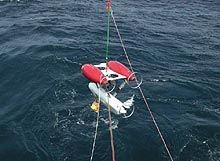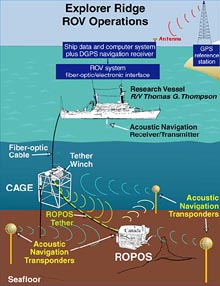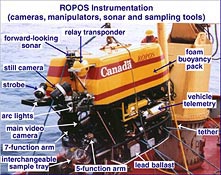
Autonomous Underwater Vehicle ABE (Autonomous Benthic Explorer) is launched over the side of a research vessel. ABE will be used to collect high-resolution multibeam bathymetry at Explorer Ridge, as well as CTD and magnetometer data. Click image for larger view.
Remotely Operated Vehicles (ROVs) and Autonomous Underwater Vehicles (AUVs
Bill Chadwick
Volcanologist
Oregon State University
Exploring the seafloor—a deep, dark, and cold environment—is extremely challenging. Because the vents are so deep, scientists cannot simply don wet suits and use SCUBA gear to explore deep-sea hydrothermal vent systems in person. Instead, scientists use high-tech robots to conduct surveys of the seafloor. Two kinds of robots used in deep-sea research are remotely operated vehicles (ROVs) and autonomous underwater vehicles (AUVs). Both are marvels of engineering. The vehicles can carry instruments, take samples and conduct surveys, while allowing scientists to follow their progress from the safety of a ship. The main difference between the two is that while ROVs are physically connected to the ship by a cable, AUVs are not connected to the ship.

Schematic image of ROPOS and its full complement of support equipment used during a deep-water deployment. Click image for larger view and more information.
Because the two kinds of vehicles have different capabilities and strengths, we will use both during our expedition to Explorer Ridge. With present technology, AUVs are best for surveys that can be programmed ahead of time and accomplished without supervision. ROVs are better suited for complex manipulations and sampling on the seafloor. One AUV used frequently in deep-sea explorations is named ABE, which stands for Autonomous Benthic Explorer. ABE is operated by the Woods Hole Oceanographic Institution in Cape Cod, Mass. It runs on batteries, and at present, can survey the seafloor on dives lasting more than a day in length. ABE is unattached and completely independent of the ship, and houses a sophisticated computer. Before each dive, it is pre-programmed to conduct specific tasks, and is then lowered over the side of the ship to begin its mission. This independence allows the ship to move around and do other things while ABE is diving, and increases the efficiency of the expedition. After a dive, ABE returns to the surface to be recovered by the ship. The information ABE collects is extremely valuable in deep-sea research. On the expedition to Explorer Ridge, for example, ABE will be used to create detailed maps of the vent areas and to measure water properties, such as temperature and salinity, which will provide guidance on where to deploy the ROV ROPOS (Remotely Operated Platform for Ocean Science) for more detailed investigations.
ROPOS is attached to the ship by a fiber optic cable and is controlled by a pilot on board the ship. The cable provides power and communication to ROPOS and allows live video and other data to be sent back to the ship as it is being collected. ROPOS is well-equipped to explore deep-sea environments; it is capable of diving to a depth of 5,000 m (almost three miles). ROPOS has a variety of sampling equipment attached to it, including two video cameras, two robotic arms for taking samples of rocks or organisms, bottles for collecting water samples, a “biobox” for collecting biological samples, a suction sampler that can “vacuum” up sediments and organisms, and a specialized water sampler for hydrothermal fluids. All of these capabilities will be used during the expedition to Explorer Ridge.
Click here for a more detailed explanation of ROPOS.
Click here for a more detailed explanation of ROVs.
Sign up for the Ocean Explorer E-mail Update List.























